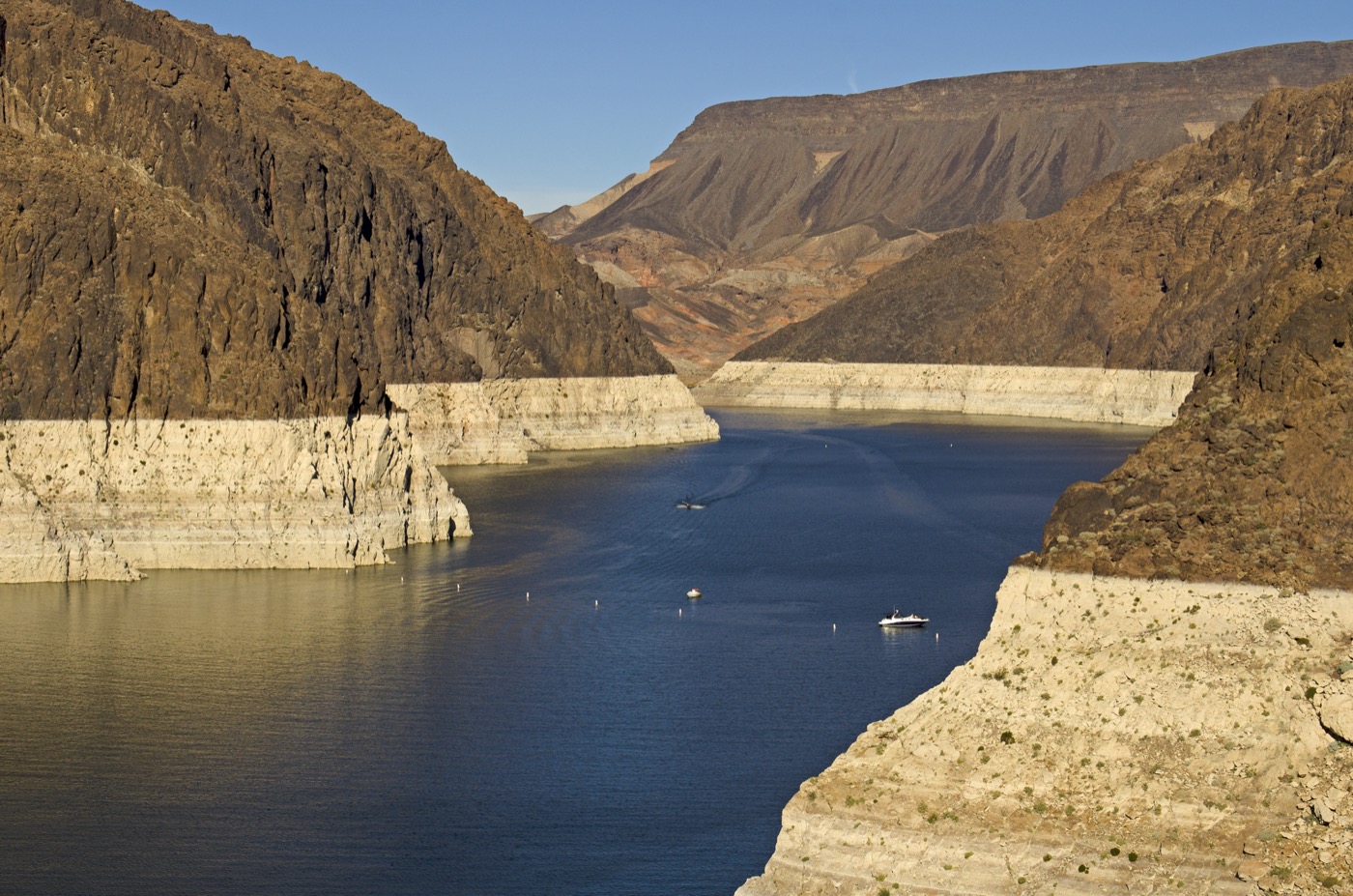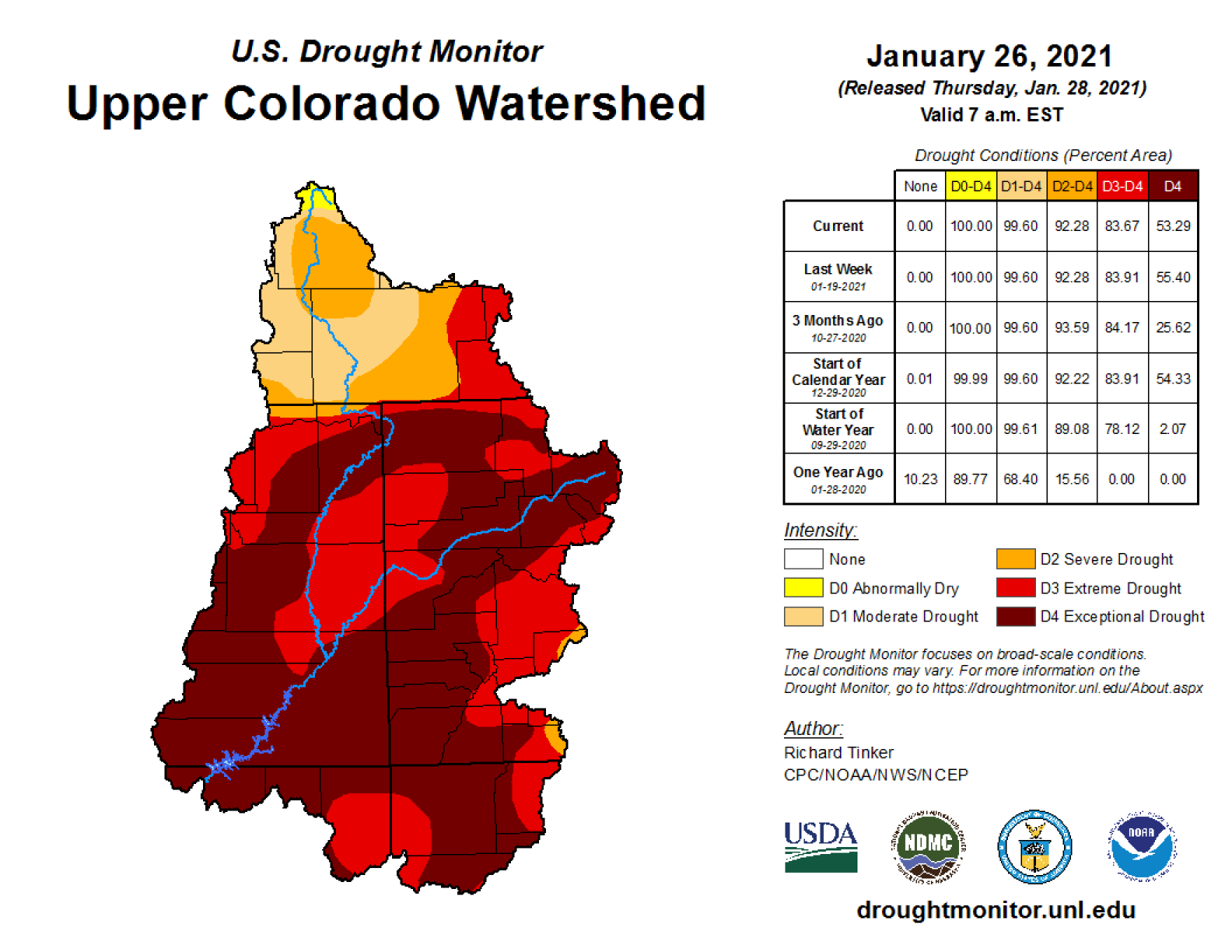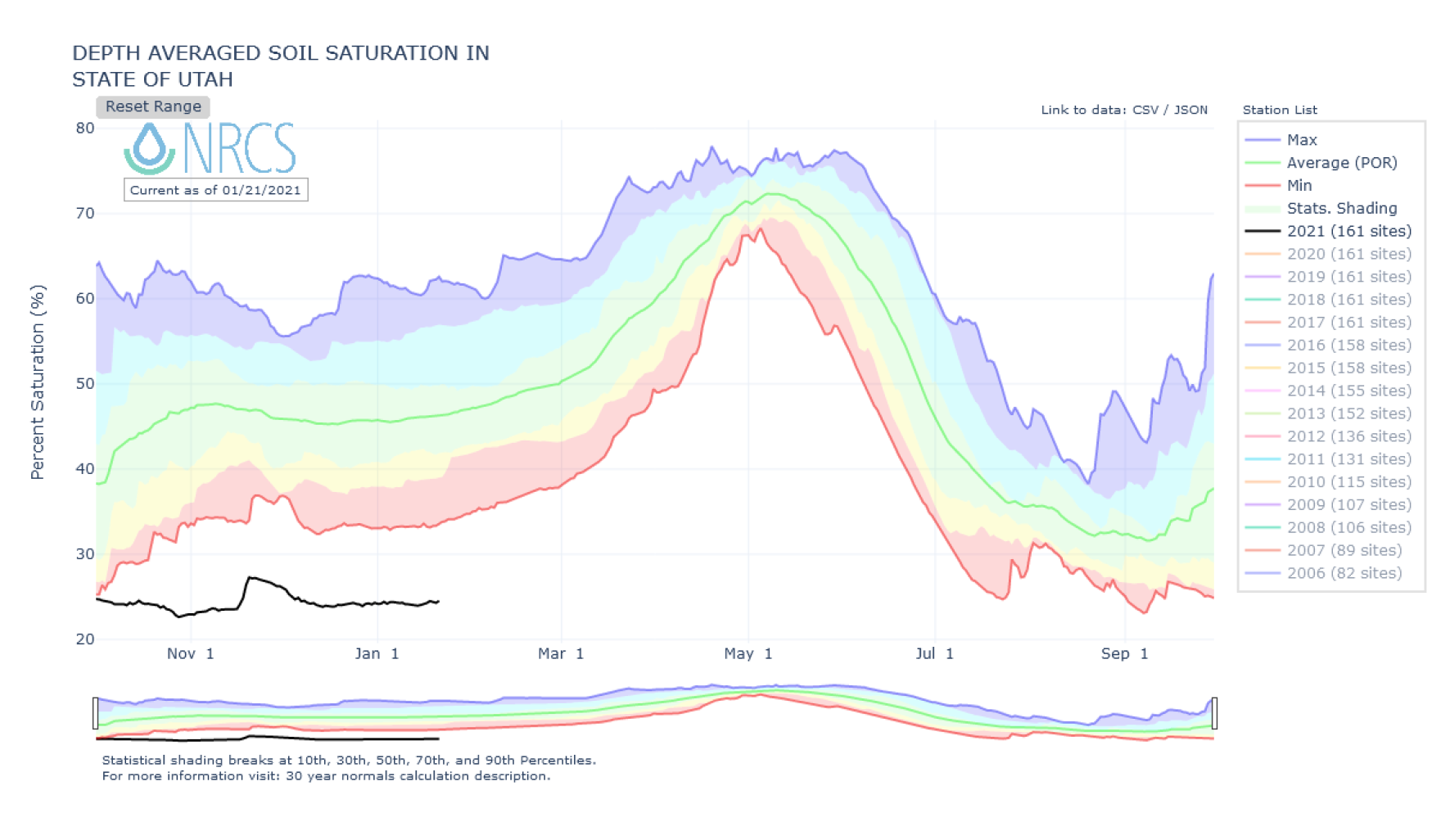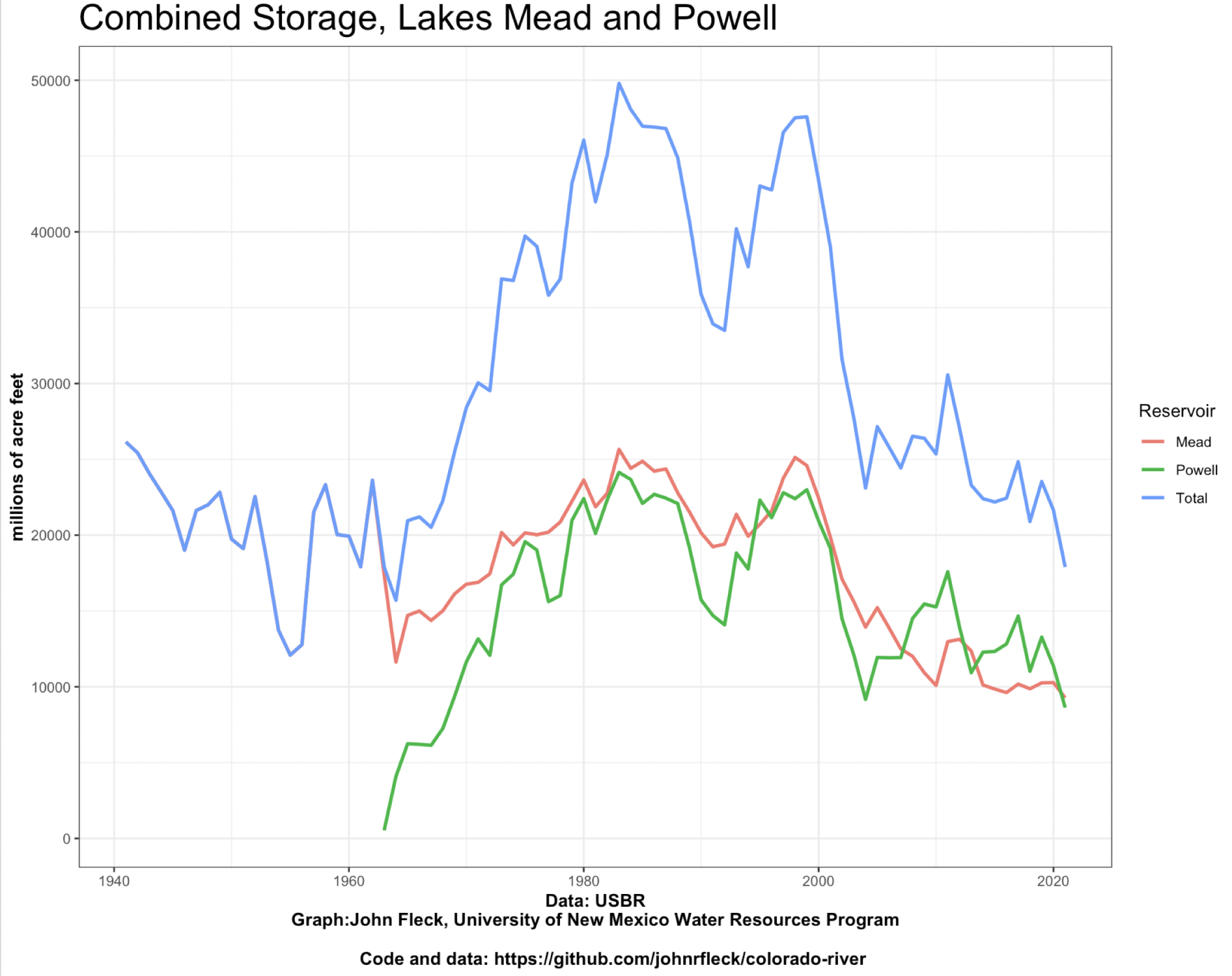What Happens When The Colorado River Runs Dry?
10:01 minutes

 This segment is part of The State of Science, a series featuring science stories from public radio stations across the United States. This story was reported by Luke Runyon on KUNC.
This segment is part of The State of Science, a series featuring science stories from public radio stations across the United States. This story was reported by Luke Runyon on KUNC.
Dry conditions are the worst they’ve been in almost 20 years across the Colorado River watershed, which acts as the drinking and irrigation water supply for 40 million people in the American Southwest.
As the latest round of federal forecasts for the river’s flow shows, it’s plausible, maybe even likely, that the situation could get much worse this year.
Understanding and explaining the depth of the dryness is up to climate scientists throughout the basin. We called several of them and asked for discrete numbers that capture the current state of the Colorado River basin.
Invest in quality science journalism by making a donation to Science Friday.
This is the highest percentage of land in the river’s Upper Basin since 2002, which stands as the region’s driest year on record. The Lower Basin fares worse, with 93% of the land area in those categories.

The basin is made up of portions of Colorado, Wyoming, Utah, New Mexico, Arizona, Nevada and California. Two Mexican states also receive Colorado River water.
Nancy Selover, Arizona’s state climatologist, says the Upper Basin figure is concerning because that accounts for the river’s headwaters. If it’s dry there, that means many more problems as the water flows downstream.
“This is when we’re supposed to be gaining and accumulating water in the form of snowpack, and that’s not happening,” Selover said.
Conditions have been deteriorating across the river basin since the summer of 2020. Monsoon rains didn’t arrive. Record-breaking high temperatures dragged well into fall. Even hardy desert plants, the ones well-adapted to water scarcity, have struggled.
“Creosote is one I personally like to call it the cockroach of the vegetation world because pretty much nothing kills creosote. It survives,” she said.
But even some creosote is dying, unable to take the one-two punch of both the hottest and driest conditions on record last year in parts of Arizona.
“People are having to do things that you don’t necessarily see, but we have water being hauled for livestock, water being hauled in for wildlife,” Selover said.
She compares the current drought conditions to 2018, another record-breaking hot and dry year just a couple years ago. It’s not quite as bad as 2002, she said, but it could easily get there.

Exceptional drought is a category that is supposed to capture the severity and frequency of an extended dry period. Climate scientists call it D4. For context, on the scale of “no drought” to “worst drought,” there’s no category that captures conditions more dry than exceptional.
“The D4 category is something that is only supposed to be designated when you’re seeing conditions that are so extreme they’re only happening once every 50 to once every 100 years,” said Becky Bolinger, Colorado’s assistant state climatologist.
The Colorado River basin has experienced three D4 droughts in the last 20 years, including the current one. 2002, 2018 and 2021 are the most intense dry periods on record for the basin.
“The droughts that we are seeing are becoming that much more severe because of the temperature component, they’re warmer,” Bolinger said.
The increase in temperatures means the atmosphere is thirstier. It sucks up moisture from forests, backyard gardens and crop fields with greater intensity.
In parts of the Colorado River basin, Bolinger said climate change has caused conditions on the ground to bump up against the designated drought categories.
“Even though conditions may be evolving and getting even worse, we don’t really have a way to depict that, because D4, that’s that ceiling,” she said.

The dryness is currently off the charts in parts of the watershed. Both Utah and Nevada experienced their driest years on record in 2020. Every other state in the watershed had one of its top five driest years on record.
Climatologist Jon Meyer with the Utah Climate Center said the number that captures the severity for him is 12 inches.
“That’s about the amount of water that our soils are behind in terms of what they normally would have,” Meyer said.
That deficit is about the same amount of precipitation that falls across Utah in an entire year. A year’s worth of rain and snow is missing from Utah’s ground.
“We are really in unprecedented territory right now, and it’s not even close,” Meyer said.
Because the deficit is so substantial, Meyer said it’s very likely the watershed will see drought conditions persist in 2021. Dry soils soak up snow when it melts, keeping it from rivers and reservoirs.
“It doesn’t matter if we get an incredible snowpack, our soils are so depleted right now that that’s not going to really translate to water coming down through the river systems,” Meyer said.
Forecasts don’t paint a pretty picture for snowpack either. It’s lagging in both the Upper and Lower basins, and the National Oceanic and Atmospheric Administration projects much of the watershed to tilt toward hotter and drier weather for the rest of the winter.

The Colorado River system’s reservoirs combined are currently less than half full. Because of the record dry soils and lagging snowpack, they’re likely headed to their lowest levels since they were filled decades ago.
“These reservoirs are as empty now as when they started filling Glen Canyon Dam in the 1960s,” said John Fleck, director of the University of New Mexico’s water resources program.
The low levels aren’t just causing hand-wringing among the West’s water officials. The dropping water and the reservoirs’ expanding bathtub rings are also tied to policy. As Lake Mead outside Las Vegas and Lake Powell in Utah decline, certain policies are triggered into action. Drought contingency plans for the Upper and Lower Basin are now in use.
The Lower Basin states of Arizona and Nevada have begun to see their deliveries from the river curtailed. Those cutbacks are likely to grow steeper in 2021. An official shortage declaration from the federal government could come as early as this year, as Lake Mead is currently projected to be below 1,075 feet in elevation at the end of 2021.
Meanwhile, Lake Powell’s projected decline in 2021 recently triggered the Upper Basin plan to be used for the first time. Water managers in the four Upper Basin states and the federal government are expected to start monthly planning calls this year to consider options for propping up the reservoir if needed.
“Reservoir storage is the best single number that captures two things: how much water nature provides and how much water humans are consuming out of that provision,” Fleck said.
“The reservoir is integrating all the problems we have, all the challenges we face show up in that one number, in that one place,” he said.
With the reservoirs approaching their lowest levels in modern history, that brings us to our final number: 2026.
That year is the deadline for water users to negotiate a new set of managing guidelines for the Colorado River.
“The challenges are really hard,” Fleck said. “And it’s easy to put them off if you get a wet year. The dry years are what force the really important steps forward in the policy community.”
The negotiations promise to be a more intense process than the basin saw in the lead-up to the last set of guidelines in 2007, or the effort to bring together drought contingency plans in 2019. Federal and state officials have committed to a more inclusive process that integrates the needs of tribes, environmental and recreation groups, and Mexico.
Meanwhile, climate change is adding pressure to the entire river system, exacerbating existing supply and demand imbalances.
Extremely dry years that produce eye-popping statistics tend to grab officials by the shoulders and give them a good shake. That’s important for the entire region, Fleck said, because the backdrop of an impending crisis will set the tone for those negotiations. For those talks to start in the middle of another record-breaking dry period should make it clear to everyone involved: the future of the Colorado River is all about learning to live with less.
This story is part of ongoing coverage of the Colorado River, produced by KUNC with financial support from the Walton Family Foundation. KUNC is solely responsible for its editorial coverage.
Invest in quality science journalism by making a donation to Science Friday.
Luke Runyon is host and producer of “Thirst Gap,” from KUNC. He’s based in Grand Junction, Colorado.
JOHN DANKOSKY: This is Science Friday. I’m John Dankosky, and now it’s time to check in on the state of science.
SPEAKER 1: This is KER–
SPEAKER 2: For WWNO–
SPEAKER 3: St. Louis Public Radio–
SPEAKER 4: Iowa Public Radio News.
JOHN DANKOSKY: Local science stories of national significance. The southwestern US has been dealing with drought conditions for years, and that’s had a big impact on the Colorado River basin. The region’s been looking warily at the reservoirs along this long river that winds its way from Colorado’s Rocky Mountains all the way to Mexico, just shy of the Gulf of California. Water levels have been getting lower and lower, and for the first time ever, a shortage seems almost certain.
This is prompting a lot of people to ask what’s going to happen next. Joining me to shed a little bit more light on this is Luke Runyon. He’s a reporter at KUNC, based in Fort Collins, Colorado. Luke covers the Colorado River basin. Welcome back to Science Friday, Luke.
LUKE RUNYON: Yeah, happy to be here.
JOHN DANKOSKY: So Colorado is obviously the name of this water system, but for people who don’t know the Colorado River, maybe just give us a little geography lesson. What states, what tribal nations, does this cut through?
LUKE RUNYON: So seven US states make up the Colorado River basin. And it’s split into two watersheds. So the upper watershed, you have the headwater states. Those are Colorado, Wyoming, New Mexico, and Utah. The lower basin is made up of Arizona, Nevada, and California.
The river also crosses over the US-Mexico border and two Mexican states, Baja California and Sonora. They both use water from the Colorado River. There is also 29 federally-recognized tribes in the basin, of which 10 of those tribes hold a significant amount of water rights from the river. And that group includes the Navajo Nation, the Southern Ute tribe, the Quechan Indian tribe. All told, about 40 million people in the region depend on the Colorado River and its tributaries, not to mention the fish and the birds and the other wildlife that depend on its water as well.
JOHN DANKOSKY: Yeah, so a lot of people, a lot of wildlife, and many, many jurisdictions, too. Give us an idea, if you would, just how low the supply is in the basin’s reservoirs right now.
LUKE RUNYON: Sure, so much of the attention in the basin goes towards the river’s largest reservoirs, which also happen to be the biggest reservoirs in the entire United States. And that’s Lake Powell in southern Utah and Lake Mead, which is on the Nevada-Arizona border near Las Vegas. They’re already low, because the entire watershed has been experiencing above-average temperatures and below-average river flows since the year 2000. And there’s already a supply-demand imbalance on the Colorado River, and the supply is shrinking faster than officials are able to shrink the demands that we have on the river.
And that’s left Lake Powell at 34% of its capacity. By the end of the summer, it’s projected to be even lower, at 29% of its capacity, which is a record low. And Lake Mead is currently at 37% capacity. It’s also headed toward a record low later this year.
JOHN DANKOSKY: So it’s not just the reservoirs, though, where you see these dramatic pictures of just how low the water is. It’s also in the groundwater, something that you can’t see. Explain that a little bit for us, Luke, and just how dire the situation is for the groundwater in the region.
LUKE RUNYON: Yeah, so this is something that is harder for us to visualize, because we’re so used to looking at reservoirs and rivers. And you’re able to say, oh, the river’s high, or the river is low. You can’t do that with groundwater. But it plays a huge role in the Colorado River basin.
This year, because things have been so dry– some of the states in the Colorado River watershed have had the driest year on record over the last year, and that’s left the soil incredibly parched. And so when you have snow that’s melting off, it gets soaked up into the ground before it flows into a river or flows into a reservoir. And that sponge is very dry right now, and it’s sucking up all of that water before it can be used as water supply.
JOHN DANKOSKY: So you know, with so many stories like this, we say, this is probably due to climate change. So Luke, I don’t know– is this all just because of climate change?
LUKE RUNYON: Yeah, and this is a question that has been of intense interest to climate scientists. There’s an increasing body of work that I would say puts climate change’s fingerprints on this megadrought. And that’s a word that you’re hearing a lot more, is “megadrought,” not just this temporary state of drought. And there is some evidence that this dry period would have happened without our greenhouse gas emissions. But the warming temperatures that we’re seeing make it considerably worse than it would have been.
And really, what we’re seeing in the basin is that warming of just a couple degrees has the potential to completely upend how the water cycle functions in the Southwest. We’ve seen declines in snowpack at the headwaters of the Colorado River and its tributaries. We’ve seen records set when it comes to dwindling soil moisture. We’ve seen evaporation increase from reservoirs and streams at higher temperatures. And as we warm even further, it makes it that much harder for our infrastructure, our water storage, to recover.
JOHN DANKOSKY: When you use the term “megadrought,” that sounds like a newer term. What about the idea of a water shortage? I said at the top that we don’t have an official water shortage. What would constitute that?
LUKE RUNYON: So in the Colorado River basin, a lot of the management of the river is tied to the level of its two largest reservoirs. So when Lake Mead declines, certain policy triggers are put in place. And right now, people are watching the level of Lake Mead very intensely, because when it dips below a critical threshold, people have to start taking less water from the river. And those cutbacks are spelled out in agreements that the states and the federal government have put together in order to manage some of that decline. And that’s really what we’re watching right now, is how low is Lake Mead going to go? And what does that mean for the users on the river?
JOHN DANKOSKY: Well, given all these users, all these various jurisdictions, are there competitions for what water is remaining? I mean, what sort of disputes are coming to the forefront because of this?
LUKE RUNYON: Well, Arizona is in the line for the steepest cuts from the Colorado River. And that’s because some of these past agreements have put that state in the most vulnerable position for cutbacks. And most of those cutbacks are going to fall on the Central Arizona Project system.
This is a 300-mile canal that runs through the deserts of Arizona to deliver water to farmers and to the Phoenix and Tucson metro areas. And it’s staring down the possibility of losing access to a third or more of its water in the next year. And you know, that’s way beyond any sort of voluntary conservation that Arizona has done up until this point. And you know, those are cutbacks that users are actually going to feel and that municipal leaders, farmers, tribal users in Arizona are having to plan for right now.
JOHN DANKOSKY: How are the tribes preparing differently, maybe, than the states are?
LUKE RUNYON: Well, this is kind of a narrative or storyline in the basin that has gotten a lot more attention recently, is how have tribal users been excluded from agreements in the past? And how can certain policy agreements, policy negotiations, be structured in order to allow tribal nations to come to the table and negotiate for future policies? You’re hearing a lot more now, especially because the interior secretary, Deb Haaland, is herself a member of a Native American tribe and has put a lot of emphasis on bringing tribes to the table, making tribal consultation a big part of the Biden administration’s priorities. So I’m guessing over the next several years, as policies are negotiated, you’re going to hear a lot more about how tribes are being involved in that process.
JOHN DANKOSKY: So obviously, people are preparing for worse times. What does the forecast look like? Are experts looking at this saying, it’s just going to get worse in the Colorado River basin?
LUKE RUNYON: Well, I don’t have a crystal ball. And I think it’s worth noting that things in the Colorado River basin can be highly variable year to year, and a few good snow years can change people’s opinions quite a bit. But there is still this fundamental supply-demand imbalance in the Colorado River basin. And even the people who say, you know, oh, just wait for it to get wet again, know that changes have to be made because of that fundamental supply-demand imbalance.
And it takes several years of good weather in order to bring the system out of drought. It’s not just like, you get a miracle year and you’re out of it. It takes sustained changes in order for these systems to recover.
JOHN DANKOSKY: Luke Runyon is a reporter based at KUNC in Fort Collins, Colorado. He covers the Colorado River basin. Luke, we’ll continue to follow your reporting. Thanks so much for joining us.
LUKE RUNYON: Thank you for having me.
Copyright © 2021 Science Friday Initiative. All rights reserved. Science Friday transcripts are produced on a tight deadline by 3Play Media. Fidelity to the original aired/published audio or video file might vary, and text might be updated or amended in the future. For the authoritative record of Science Friday’s programming, please visit the original aired/published recording. For terms of use and more information, visit our policies pages at http://www.sciencefriday.com/about/policies/
Kathleen Davis is a producer and fill-in host at Science Friday, which means she spends her weeks researching, writing, editing, and sometimes talking into a microphone. She’s always eager to talk about freshwater lakes and Coney Island diners.
John Dankosky works with the radio team to create our weekly show, and is helping to build our State of Science Reporting Network. He’s also been a long-time guest host on Science Friday. He and his wife have three cats, thousands of bees, and a yoga studio in the sleepy Northwest hills of Connecticut.